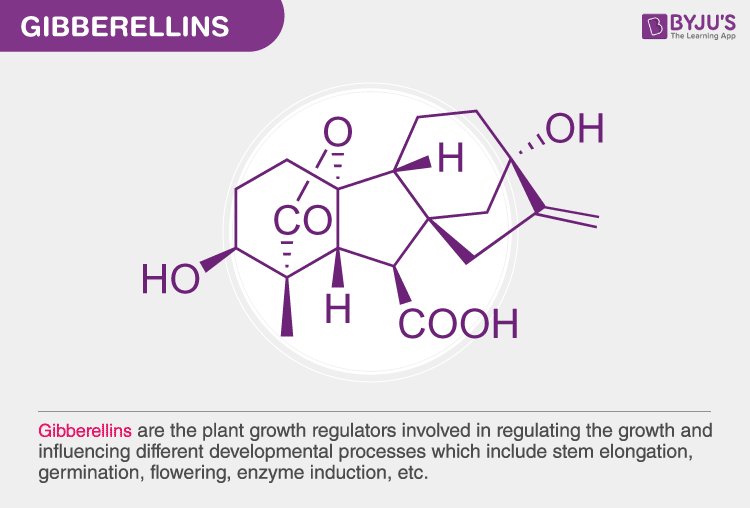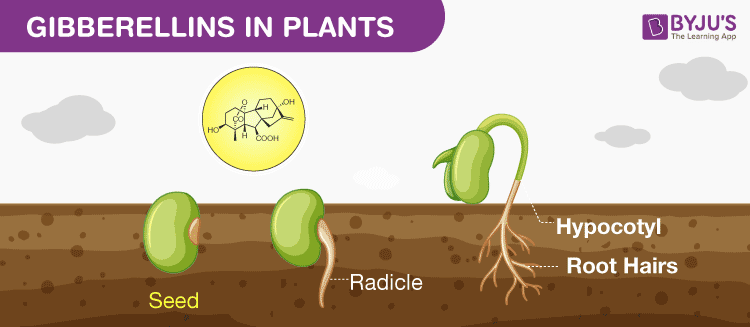As, we humans have different types of hormones, a chemical messenger produced by the endocrine glands to perform several metabolic activities within the body.
Like humans, plants also have five major types of plant hormones which are collectively called as plant growth regulators, promoters, inhibitors, and phytohormones.
In this article let us learn more in detail about the Gibberellins – the largest known classes of the plant hormone.
Gibberellins Definition
“Gibberellins are any group of plant hormones that stimulate elongation of the stem, flowering and germination.”
What are Gibberellins?
Gibberellins are the plant growth regulators involved in regulating the growth and influencing different developmental processes which include stem elongation, germination, flowering, enzyme induction, etc.
Gibberellins have different effects on plant growth and the stem elongation is the most dramatic amongst all. The stem starts to grow when it is applied in low concentration to a bush. The internodes grow so long that the plants become indistinguishable from climbing. The Gibberellins overcome the genetic limitations in different dwarf varieties.
There are more than 70 gibberellins isolated. They are GA1, GA2, GA3 and so on. GA3 Gibberellic acid is the most widely studied plant growth regulators.
Also Read: Ethylene
Gibberellin Structure

Gibberellin Structure
Gibberellin is a diterpenoid. It forms the basis of molecules such as vitamins A and E. The figure above shows the structure of the Gibberellin A1, the first identified gibberellin.
The structure of all the gibberellins is the same with several side groups attached. These groups determine the unique functions of gibberellins in different tissues.
Function of Gibberellins

Gibberellin function in plants
The important gibberellins function are mentioned below:
Seed Germination
Some seeds that are sensitive to light such as tobacco and lettuce exhibit poor germination in the absence of sunlight. Germination begins rapidly if the seeds are exposed to the sunlight. If the seeds are treated with gibberellic acid, the light requirement can be overcome.
Also, read about Seed Germination
Dormancy of Buds
The buds that are formed in autumn stay dormant until next spring. This dormancy can be overcome by treating them with gibberellin.
Root Growth
Gibberellins have almost no effect on the growth of roots. However, some inhibition of growth can occur at a higher concentration in a few plants.
Elongation of the Internodes
Internodes elongation is the most pronounced effects of gibberellins on plant growth. In many plants such as dwarf pea and maize, the genetic dwarfism can be overcome.
For example, the dwarf pea plants have expanded leaves and short internodes. But the internodes expand and look like tall plants when treated with gibberellin.
Gibberellins exhibit their impact by altering gene transcription.
The steps of gibberellin functions are mentioned below:
- The GA enters the cell and binds to a soluble protein receptor.
- This binds to a protein complex (SCF) that attaches ubiquitin to one or the other DELLA proteins.
- This activates the destruction of DELLA proteins through proteasomes.
- The destruction of DELLA proteins releases the inhibition and gene transcription starts.
This procedure is amongst different cases in biology where the pathway is turned on by inhibiting the pathway. However, most of the proteins that are involved differ according to circumstances, both auxin and gibberellins influence gene expression by a common mechanism of repression relief.
Uses of Gibberellins
Gibberellin is commercially obtained from fungi. It is used to facilitate the germination of seeds.
It is sprayed on the grapevines and used to enlarge them.
It is used on cucumber plants to produce all-male flowers. This helps the farmers to obtain pollen of desired characteristics to be used for hybridization.
Biennial plants produce flowers only during low temperatures. When gibberellin is applied, these plants will flower irrespective of the low temperatures.
The dwarf varieties of plants which are genetic mutants can be made to grow by applying gibberellins to them.
Also Read: Cytokinin
Learn more about gibberellins, its definition, function, uses and other plant growth regulators @ BYJU’S Biology
Frequently Asked Questions
What is the main function of gibberellins?
Gibberellins are plant growth regulators that facilitate cell elongation, help the plants to grow taller. They also play major roles in germination, elongation of the stem, fruit ripening and flowering.
How do human use gibberellins?
Gibberellins are utilized by the farmers to speed up the germination of seeds and to stimulate cell and stem elongation. These are applied externally to increase crop production.
Where are gibberellins formed?
Gibberellins are formed in the plastids by the terpenoid pathway and then transformed in the endoplasmic reticulum and cytosol until they reach their biologically active form.
How do gibberellins initiate seed germination?
Gibberellins synthesize and produce hydrolases such as amylase which helps in the germination of seeds. The hydrolases breakdown the macromolecules in the endosperm to provide nutrients to the embryo. Thus they directly stimulate the growth of the embryo and enhance seed germination.
How do gibberellins promote flowering?
Gibberellins promote flowering in Arabidopsis by activating the LEAFY promoter. Severe reduction in gibberellins delays flowering during long days and prevents flowering during short days.
How do gibberellins initiate cell elongation?
Gibberellins alter the rheological properties of the cell wall. As a result, the water potential of the cell is lowered that allows the uptake of water and increases the cell volume.
How is the plant hormone auxin different from gibberellin?
The most important differences between auxin and gibberellin are that auxin promotes the growth of shoot whereas gibberellin is involved in the elongation of the stem, flowering and seed germination. Auxin plays a major role in apical dominance whereas gibberellin has no role in apical dominance.
How was gibberellic acid discovered?
Gibberellic acid was discovered by Kurosawa, a Japanese Botanist while investigating the rice foolish seedling disease.

Are gibberellins play role in plant cell division?